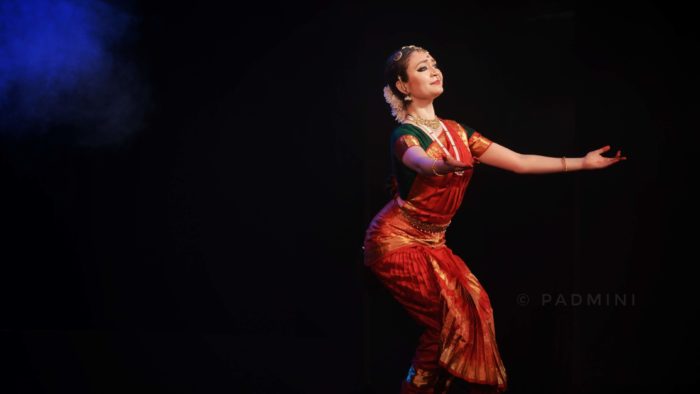A Chemistry Major at the University of Columbia, Sophia Salingaros performed at the United Nations on World Yoga Day last year along with other Bharatanatyam dancers, as part of an ensemble. She is studying to be a doctor and hopes that one day she can heal people through both her medical practice as well as her dance.
Born in San Antonio, Texas, Sophia began learning dance at the age of nine with her guru Dr Sreedhara Akkihebbalu. She began learning ballet when she was five and loved it. “A family friend who taught Bharatanatyam at a local school came over for dinner one day and told my mom I should come try it, since I like ballet so much. My European parents were apprehensive to start at first, but after my first Bharatanatyam class I fell in love with it and insisted to keep learning. Fourteen years later, it has become an integral part of my life,” Sophia tells CSP.

In the middle of her course at Columbia, she is a part of the Aseemkala Initiative exploring the connection between health and classical dance (more information here https://aseemkala.org/our-elevator-pitch/). Sophia says there is no doubt that any art form can be connected to healing in a way drugs cannot be. “Traditional arts have the ability to heal in a way that no medical treatment or pill can. I have performed for nursing homes and inpatient facilities and seen decrepit, wheelchair bound patients perk up to the sound of my bells or the movement of my body. I have also participated in socially conscious performances that have moved perfectly functional, outwardly healthy, audience members to tears because they know that someone close to them struggles with the issues depicted through the dance.”
In 2018, Sophia was invited by the Prime Minister of the United Arab Emirates to introduce herself at the World Government Summit in Dubai to the Prime Minsiter of India, Narendra Modi. A student of Indian Bharatanatyam guru Rama Vaidyanathan, she has also studied in the Ballet Bolshoi Academy in Moscow for six months. The connect between the body, mind and health have led her to research various aspects of dance. “As a dancer and an aspiring doctor, I am immersing myself both in the world of art and healthcare. I believe that bringing the two together can greatly benefit a system of healing people by bringing a more humane aspect to treatment. While modern medicine has worked wonders in improving the quality and length of life today, art still plays a fundamental role in healing that cannot be recreated,” says Sophia.
She has also conducted research on the Hidden Epidemics of Eating Disorders in Dancers focusses on the problem faced by ballet and Bharatanatyam dancers “who struggle with healthy eating and body image.”
https://www.youtube.com/watch?v=R8J6BYFjwEw&feature=youtu.be
In her dance performance of the theme, she ends by breaking the mirror and walking away depicting hopes of recovery. “The haunting sitar music by Anoushka Shankar slowly slinks down the musical scale, imitating how the numbers slide down on the weighing scale.”
Talking about the problem, Sophia says, “It varies according to the individual, but I believe most dancers are perfectionists and therefore are never fully satisfied with their level of skill or their body image. Societal pressures on women performers especially for the "perfect body" can cause self-doubt which may eventually lead to body dysmorphia and eating disorders. I think Indian dance promotes a much healthier body standard than ballet for example, and the emphasis is much more on what the body can do rather than what it looks like.”

The art of Bharatanatyam itself appeals to her because “The story telling of Bharatanatyam trains one to express any emotion or narrative through facial expressions, which is not always taught in other dance forms. It can absolutely be applied to any other style, or even to acting. The emotions portrayed in Bharatanatyam are universal and can be understood and empathized with regardless of the audience's cultural or religious background.”
For early learners, Sophia says having very defined codes definitely makes the initial learning process easier, “as there is a very strict path through which a dancer progresses. From the basic stance, through the first adavus, to the more complicated jathis, from the basic items to the more complex, culminating in a graduation performance - it is helpful to have the journey mapped out for a young dancer.” Post the arangetram, “there is no clearly defined path, which is at the same time exciting and intimidating. That is when an artist must develop their own voice and start to make their own unique mark on the art form.”
For her the most challenging aspect was to understand the languages in which the dance items were composed in. “To master this, my gurus translate every word into English, which I write down in a notebook and memorize. That way I am aware of every word of the poetry, and am able to convey the correct meaning.”
She cherishes her experience with her gurus Dr Sreedhara Akkihebbalu and Rama Vaidyanathan. “They have moulded me into the dancer I am today. My favourite memory is when my guru Dr Sreedhara Akkihebbalu took me to India for my first performance tour and performed nattuvangam for my first live music margam ever. It was a very special memory.”
Sophia Salingaros is discovering what thousands of Bharatanatyam dancers have felt for millennia about the spiritual art form. “Learning Bharatanatyam has brought meaning into my life. I don't know who I would be without it. I hope to use my dance and story to share the message that art should have no cultural or religious boundaries. When I receive messages from dancers around the world that my videos have inspired them to take up dance or to practice more, it makes me feel like I am a making a small but significant impact on the world.”





